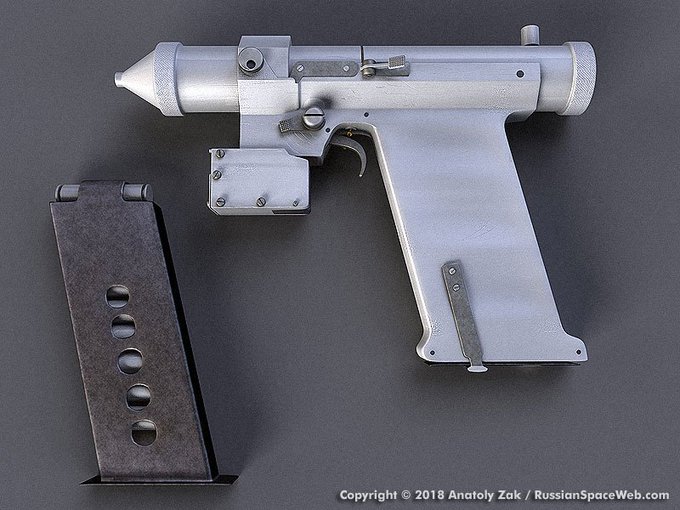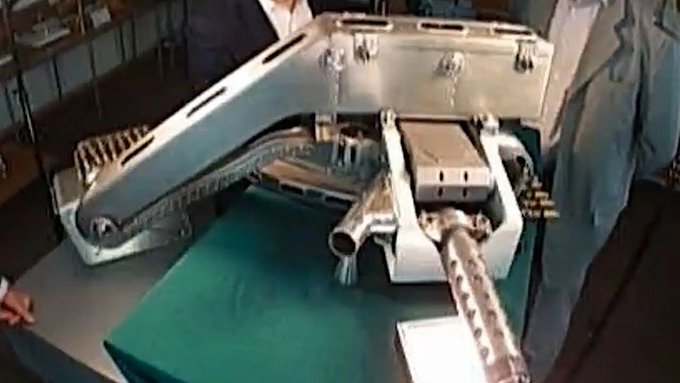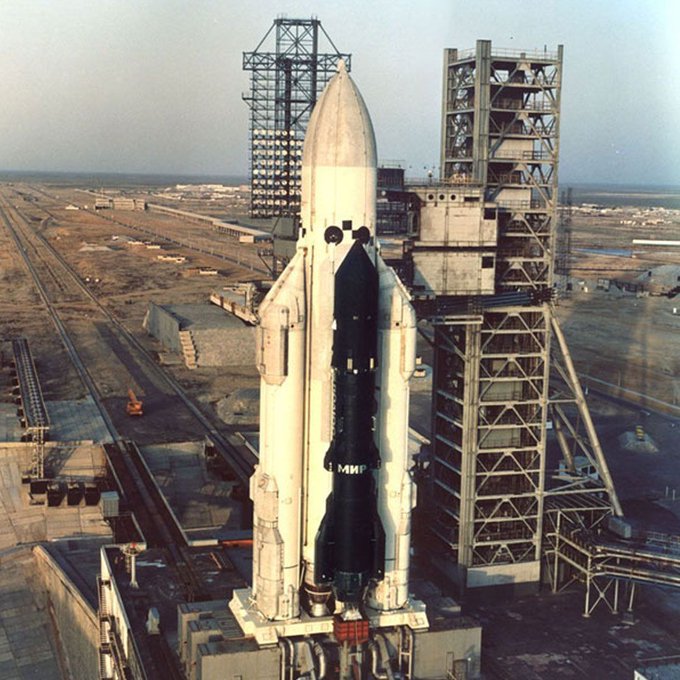Craziest Soviet Space Projects

November 24, 2024
•21 min read
Let's check out the Soviet Union's craziest space projects!
Space fighters and laser pistols sound like pure science-fiction, but they’re examples of real projects that the USSR developed during the Space Race. The Soviet Space Program was responsible for revolutionary inventions and catastrophic failures, including gigantic orbiting mirrors, a space-station armed with a machine-gun and robots that successfully landed on Venus. Let's travel back to the Cold War, as we check out the Craziest Soviet Space Projects!
Laser Space Pistol
In the 1950s, the Cold War between the USA and the Soviet Union led to the Space Race, where both countries competed to have the best space program. The race continued until the USSR fell in 1991 and it led to some crazy advancements in space technology, as the USA landed on the moon in 1969 and the Soviets developed some amazing sci-fi weapons.
The real-life raygun in the image below is The Laser Gun with Pyrotechnic Flash Lamp; a working space-weapon that fired an 8540°F laser beam. That’s hot enough to melt diamonds, and the device worked like a semi-automatic handgun, as each shot used a small laser-generating lamp before a new one was automatically fed into the chamber.The Soviet Union's Space Laser Pistol, Revealed popm.ch/3uBzWsq by @russianspaceweb
Rikhter R-23 Space Cannon
In the 1960’s, it felt like the United States and the USSR could attack the other at any given moment. So, the Soviets wanted to become the first superpower to build a military presence in space. They did this by founding Almaz; a top-secret program that developed three militarized space stations that could be used for surveillance on America. This included the Salyut-3, which became the world’s only armed space station after it was sent up to orbit with a giant Rikhter R-23 cannon.
#USSR #ISRO -First & only gun to be fired in #space -More than 4 decades after #Soviet Union's 23mm R-23M automatic cannon fired new pictures of this secretive weapon hv emerged -Shchit-1 self-defense system that armed Almaz OPS-2 military space station, orbited Earth in 1974-75

Znamya Space Mirror Satellite
Some bosses are obsessed with boosting their workers’ productivity, and the leaders of the USSR weren’t any different. In 1988, they plotted to literally increase the length of the working day by placing a giant mirror in orbit, that would reflect sunlight back to the Soviet Union at night. This would make it light after the sun had set; allowing their citizens to work later while also providing extra energy through solar power.

Spiral Orbital Fighter
When Star Wars was released in 1977, its X-Wings and Tie-Fighters seemed like mind-blowing science-fiction. However, the Soviet government must’ve thought the movie was pretty boring, because they’d been developing a real space plane since 1965 called the Spiral Orbital Fighter.
This small plane would initially be launched on the back of a hypersonic jet. Then, when it reached a high-altitude, it would fire its boosters to push itself into space. Once it left Earth’s atmosphere, the Spiral would allegedly be able to fly around at eight times the speed of sound, while taking reconnaissance photos and firing missiles at targets in space and on Earth. However, the vehicle was incredibly expensive and complicated to produce, so it was cancelled in 1978 before it was tested in orbit. The concept of a re-usable space plane lived on in 1988 with the MAKS orbiter; a proposed spacecraft that was designed to carry cargo into orbit to resupply space stations. The re-usable spacecraft would be carried to a high altitude on the back of a gigantic AN-225 Mriya plane. Then, MAKS would separate from the plane and propel itself into orbit using the booster fuel in its giant zeppelin-shaped fuel tank, which would detach and fall to the ground after use.Buran Shuttle
In 1981, NASA got into the space-plane game with the launch of the Space Shuttle; a re-usable vehicle that could launch like a regular rocket and land back on Earth like an airplane. It was primarily used to deploy satellites and serve as an orbiting laboratory, but the Soviets were worried that America would use it to bomb Moscow from space, so they started working on their own shuttle to compete. This was the largest and most expensive space project in Soviet history, but in 1988 the USSR finally unveiled the Buran, which looked suspiciously similar to its American counterpart.
It turns out, when the Soviets started developing the Buran, they discovered that NASA’s Shuttle program wasn’t classified, so it was incredibly easy for their spies to steal the blueprints and smuggle them home. This let the Soviet engineers copy the US, but in their defense, the Buran wasn’t a complete clone, and they actually managed to improve the design. Their craft could carry more supplies than America's and it could land under remote control with no crew on board. The Buran’s debut launch in 1988 went perfectly. But unfortunately, the Soviet Union collapsed before its second flight could take place in 1991. As a result, the Buran never flew again and the three that had been built were abandoned at the Baikonur Cosmodrome in Kazakhstan. The only one that had been to space rusted away in a hangar for years, until the roof collapsed in 2002, completely destroying one of the Soviet Space Program’s most important artefacts.Polyus Spacecraft
As the USSR pushed to build a military presence in space, they developed some projects that are ripped straight out of the script of a science-fiction movie. One of the craziest examples was Polyus; a satellite that was designed to shoot down American spacecraft with a powerful carbon dioxide laser.
A strange one for you, the Russian Polyus spacecraft looking sinister strapped to a Energia rocket. The Polyus was an orbital weapons platform designed to destroy satellites with a laser. It was launched on May 15, 1987 and reportedly failed to reach orbit. Credit: Unknown

Luna-15
In July 1969, NASA was getting ready to win the race to the Moon by launching Neil Armstrong, Buzz Aldrin and Michael Collins on Apollo 11. The Soviet’s had already landed their unmanned Luna-9 probe on its surface and snapped some photos in 1966.
But Apollo 11 would overshadow their achievements, so the USSR made a Hail-Mary play by launching another moon mission three days before the Americans left Earth. Their Luna-15 craft was unmanned, but they hoped to use its robotic arm to collect some Moon rocks and beat Apollo 11 back home to make NASA’s achievement seem less impressive.This meant the race ended with a final sprint, as Apollo 11 and Luna-15 flew to the Moon at the same time! The Soviet’s reached lunar orbit first, but they delayed landing due to the uneven terrain at the landsite. While they waited, the Americans reached the surface and planted the Stars and Stripes, so the Soviets forced a landing and crashed Luna-15 into the Moon at 298mph. Armstrong and Aldrin were still on the surface when Luna-15 smashed into it, but luckily, they were 350 miles from the crash site.
Soyuz-1 & N1
Landing a human-being on the moon was a key leg in the space-race, but unfortunately the Soviet’s had trouble developing rockets and spacecraft that could get the job done. In 1967, the cosmonaut Vladimir Komarov was launched to Earth’s orbit onboard the Soyuz-1, to test technology that could eventually be used on a Moon mission.
The Soviets scheduled the launch to take place on the birthday of the USSR’s deceased founder Vladimir Lenin, but as the date rolled around, there were still more than 200 problems with the spacecraft. Despite this, the USSRs leaders made the mission launch anyway to meet their deadline, and when Soyuz-1 reached space, one of the solar panels didn’t open which halved the amount of available power. Then, at the end of the mission, when Komarov tried to bring the capsule back to Earth, the parachute didn’t deploy properly. As a result, the capsule smashed into the ground at 90mph and exploded, blowing out Lenin’s gigantic birthday candle, and making Komarov the first Earthling to venture to space and never return home.

Zvezda Moonbase
The Soviet’s lost the space-race when their nation dissolved in ’91. But they started it in 1957, by launching the first man-made satellite into orbit; a primitive, basketball-sized sphere called Sputnik-1.
This was a huge advancement in space travel, and the success made the Soviet’s so over-confident that the very same year, they announced that they’d be able to build a permanent base on the Moon in the near future. They then started developing “Zvezda”, a conceptual moon-base that would be powered with nuclear energy and giant solar panels. Inside, Zvezda would have space for 12-people to live comfortably, with a greenhouse to help oxygenate the air and a water recycling facility to keep the cosmonauts hydrated.The Moon doesn’t have an atmosphere to block radiation from the sun, so its surface is exposed to 150-times more cosmic radiation than Earth. To counteract this, parts of Zvezda would’ve been completely buried under lunar soil that would shield it from the deadly sun, and further protect the base against stray meteorites. The Soviets really thought the plan through, but in hindsight, it was unbelievably ambitious to think about building a moon-base in the 1950s. The USSR never managed to land a single person on its surface, so they weren’t able to build Zvezda, and they probably should’ve tried visiting the moon before making plans to build on it!Soviet Venera Program
Lots of countries are currently working on missions to Mars, with the eventual goal of landing astronauts on the red planet. However, the Soviets were way ahead of their time, and they started to develop plans for a manned Mars mission back in the 1960s. Their craziest plan involved the MPK; a proposed 1800-ton, nuclear-powered spacecraft that would have to be constructed in space.

Alexi Leonov's Spacewalk
Being an astronaut is pretty dangerous, and one of the scariest jobs they perform is a spacewalk or EVA. Climbing around the outside of a space-station comes with a lot of risks, and when Alexei Leonov performed the very first spacewalk in 1965, it almost cost him his life.

Cosmonauts Stuck In Space
During the Cold War, the Soviet government wanted to appear more powerful than the US. So, when their space missions failed, they kept it very hush-hush, and they even attempted to cover some of their failures up. In 1961, a trainee cosmonaut called Valentin Bondarenko suffered catastrophic burns after a fire broke out in a simulated spacecraft. His injuries were fatal, but he was brought to a doctor under a fake name and buried discreetly, so the public and US government wouldn’t learn about the accident.
Officially, there were no Russian cosmonauts in space at the time, so when the brothers shared recordings of the broadcast it attracted lots of media attention and turned them into small-time celebrities. The brothers released more recordings of breaths and heartbeats that they’d supposedly picked up from orbit, and people started to theorize that the Soviet Union had abandoned several cosmonauts in space after a failed mission. The theory grew in popularity, although suspiciously, no-one else recorded these transmissions, and Russians who’ve listened to the recording of the female cosmonaut have stated that she had a terrible Russian accent that sounded suspiciously Italian. As a result, most experts believe that while the Russian’s did cover-up the Valentin Bondarenko incident, there probably aren’t lost cosmonauts floating around in orbit, and the Cordiglia brothers invented the story for attention. Still, the theory that the Soviet Union abandoned their cosmonauts kind of came true when the Soviet Union fell, and their very last astronaut got stuck in orbit. Sergei Krikalev was still onboard the MIR space station in 1991, so when the USSR disbanded he didn’t technically have a country to return to. The newly-independent Russia was undergoing political chaos so they didn’t prioritize getting Sergei home, and he stayed on the station for 311-days.
Raketa Hydrofoil Boat
The Space Race was an important period for the USSR’s culture, and it inspired a generation of Soviet artists and engineers to create space-themed monuments, vacuum cleaners, and a special type of boat called the “Raketa” or ‘Rocket.’
The literal rocket ship sailed on-top of hydrofoils; leg-like structures with a plate on the end that lifts the vessel’s hull out of the water. This drastically reduced the amount of drag on the boat, which allowed them to travel at 40mph, 3-times faster than most similarly-sized vessels.

















](https://beamazed.b-cdn.net/dfhvoxjgb/image/upload/v1716778339/what-famous-historical-figures-really-looked-like/5nKJ7BatDrAeUvwVT4ZUNW.jpg?width=400)









